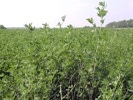June 1, 2010

Seven years of research at Ohio State University's South Centers at Piketon have found that cover crops such as cow pea or winter pea worked into a corn/soybean/wheat rotation can produce enough nitrogen to support at least 150 bushels of corn per acre.
The findings indicate farmers can save money on spring nitrogen fertilizer applications while reaping the environmental benefits of cover crops.
"Cover crops produce enough nitrogen to where farmers many not need to add nitrogen fertilizer to their corn crop, but if they want to be sure of maximizing their yields, farmers can supplement the cover crops with 25 to 30 pounds of nitrogen fertilizer," says Rafiq Islam, an OSU Extension soil scientist. "That's more than enough a farmer needs to support the corn crop."
Continuous no-till is a challenge for many Ohio farmers because of the hits they take in yields, soil compaction, weeds and other environmental difficulties.
"No-till farmers face yield reductions right off the bat – 20 to 25% – and those yield reductions last a good four or five years until the soil adjusts to the new production system," says Islam. "Also, they face compaction issues, weed control problems, wet fields, and the immobilization of nitrogen because of the increased carbon being stored in the surface soil."
Throw cover crops into the production mix and the time it takes to recover from yield losses is cut in half, he says.
In addition, cover crops help alleviate environmental problems. For example, including a few pounds of oilseed radish with legumes can substantially improve the benefits of cover crops.
"The roots of oil seed radish can reach deep into the soil – as much as 30 inches – breaking up compacted soils (natural strip tillage), supporting microbial diversity, facilitating drainage and improving soil structure," said Islam "If you grow a legume cover crop along with oil seed radish, you don't need to subsoil or deep plow. The crops work together as a natural biological plow."
OSU Extension is releasing a series of cover crop fact sheets throughout 2010, as well as provide production information during workshops and field days. A plethora of cover crops fact sheets are available on OSU Extension's Ohioline at ohioline.osu.edu. Search for "cover crops." Look for more information at the Midwest Cover Crops Council web site at mccc.msu.edu.
You May Also Like




